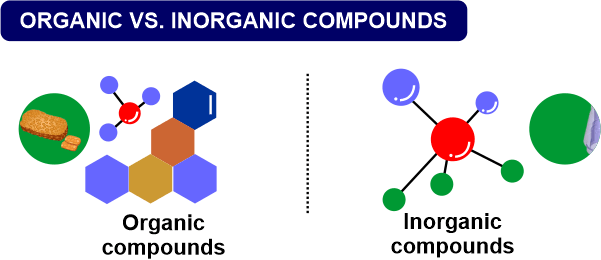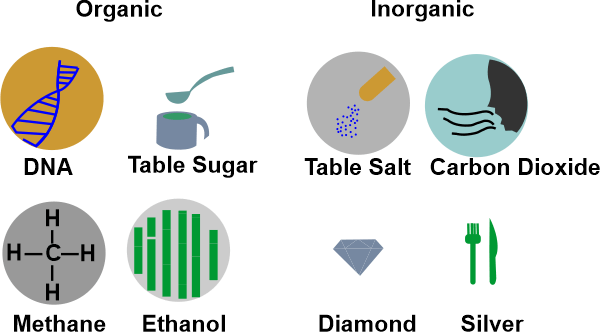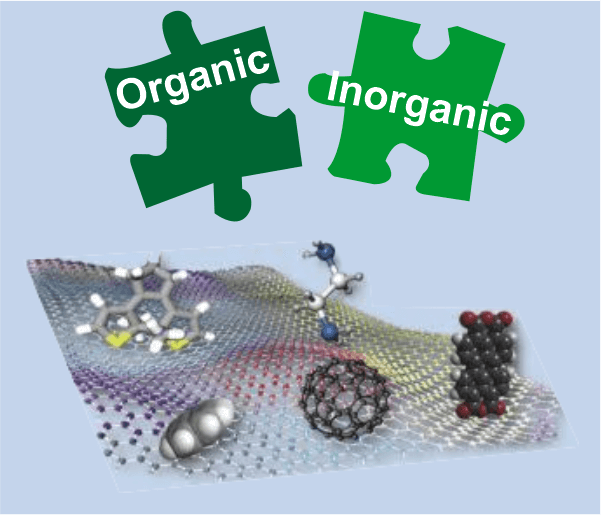Difference between Organic and InorganicOrganic and inorganic compounds are the basic components of chemistry. The main distinction between organic and inorganic compounds is that organic compounds always contain carbon, whereas most inorganic compounds do not. Furthermore, almost all organic compounds contain carbon-hydrogen or C-H bonds. It should be noted that merely having carbon in a compound does not make it organic. Organic CompoundsOrganic compounds are chemical compounds that have carbon-hydrogen or carbon-carbon bonds. Because of carbon's strong tendency to catenate (form chains with other carbon atoms) millions of organic compounds are well-known. Organic chemistry is the study of the properties, reactions, and synthesizing of organic molecules. For historical reasons, a few categories of carbon-containing compounds (like carbonate salts and cyanide salts) and a few other exceptions (like carbon dioxide and hydrogen cyanide) are classified as inorganic but not organic. Other than those just named as organic, the little clear consensus among chemists on exactly which carbon-containing compounds are exempted, making any precise definition of an organic compound will be elusive. While living organisms create most organic compounds in chemistry, the molecules can also originate through other methods. 
For example, when scientists discuss organic chemicals identified on Pluto, it does not imply that there are aliens on the planet. Solar radiation can generate energy for synthesizing organic molecules from inorganic carbon compounds. Although organic molecules comprise only a minor part of the Earth's crust, they are critical since all known life relies on organic chemicals. Living things convert inorganic carbon compounds into organic carbon compounds through a network process that begins with autotrophic organisms converting carbon dioxide and a hydrogen source like liquid into simple sugars and other organic molecules using light (photosynthesis) or other energy sources. Most synthetically generated organic compounds are sourced from petrochemicals and primarily hydrocarbons synthesized underground over geological timeframes by the high pressure and temperature breakdown of organic matter. Organic chemicals, regardless of their ultimate source, are no longer defined as compounds emerging in living organisms, as they were historically. Examples of Organic CompoundsOrganic compounds are those found in living creatures. Examples include nucleic acids, lipids, carbohydrates, proteins, enzymes, and hydrocarbon fuels. Carbon, hydrogen, and oxygen are all elements present in all organic molecules in different amounts.
Applications of Organic Compounds
Inorganic CompoundsAny chemical that is not organic is considered an inorganic compound. In other words, inorganic substances do not consist primarily of carbon atoms. Carbon atoms can either be present or absent. Inorganic chemistry studies the structures, performance, properties, and features of inorganic substances. Minerals, metal-bound compounds, and organometallic compounds are the most common inorganic compounds. Many inorganic substances can conduct electricity because they are made of metals or metal ions. 
Some inorganic substances, such as graphite, can conduct electricity even without the presence of a metal. Ionic and covalent bonding is found in most inorganic substances. Because of d-block elements, many inorganic compounds are likewise quite colorful. Because of their ionic interactions, most inorganic compounds are water-soluble. When put into water, they can break into their ions. Another significant feature is their ability to create crystals. Their connecting nature also contributes to this potential. Inorganic Compounds ExamplesInorganics include salts, metals, single-element compounds, and other compounds that do not contain carbon linked to hydrogen. Carbon is found in certain inorganic compounds.
Applications of Inorganic CompoundsInorganic compounds have a wide range of applications. Such compounds are present in our daily lives and are widely used in various businesses. They are involved in the production of pigments, pharmaceuticals, and coatings. They are even utilized as catalysts, such as platinum which is used as a catalyst in the manufacture of sulfuric acid. The most well-known inorganic material is salt, also named table salt, which is used in cooking. A few examples of inorganic compound applications are as follows.
Difference Between Organic and Inorganic CompoundsChemists made numerous unsuccessful attempts to manufacture organic molecules in the laboratory during the early years of the development of chemistry. After many failures, they were driven to conclude that organic molecules can only be created by a specific mechanism that occurs only inside living creatures. As a result, organic substances cannot be synthesized in a laboratory, unlike inorganic chemicals. Organic molecules make up most of all creatures. Carbohydrates, proteins, lipids, and other chemical compounds are very crucial to us. 
The interaction of carbons and hydrogen produces organic compounds. On the other hand, these bonds do not exist in inorganic compounds. Here are some differences between organic and inorganic compounds
The ConclusionOrganic chemistry, inorganic chemistry, physical chemistry, and analytical chemistry are the four major branches of chemistry. Organic chemistry, for example, is accountable for the structure, properties, and reactions of organic compounds. The study of the structure, properties, and reactions of inorganic compounds is known as inorganic chemistry. Thus, the distinction between organic and inorganic chemistry stems from the distinction between organic and inorganic compounds, which is determined by the presence or absence of carbon atoms in their structure.
Next TopicDifference between
|
 For Videos Join Our Youtube Channel: Join Now
For Videos Join Our Youtube Channel: Join Now
Feedback
- Send your Feedback to [email protected]
Help Others, Please Share










